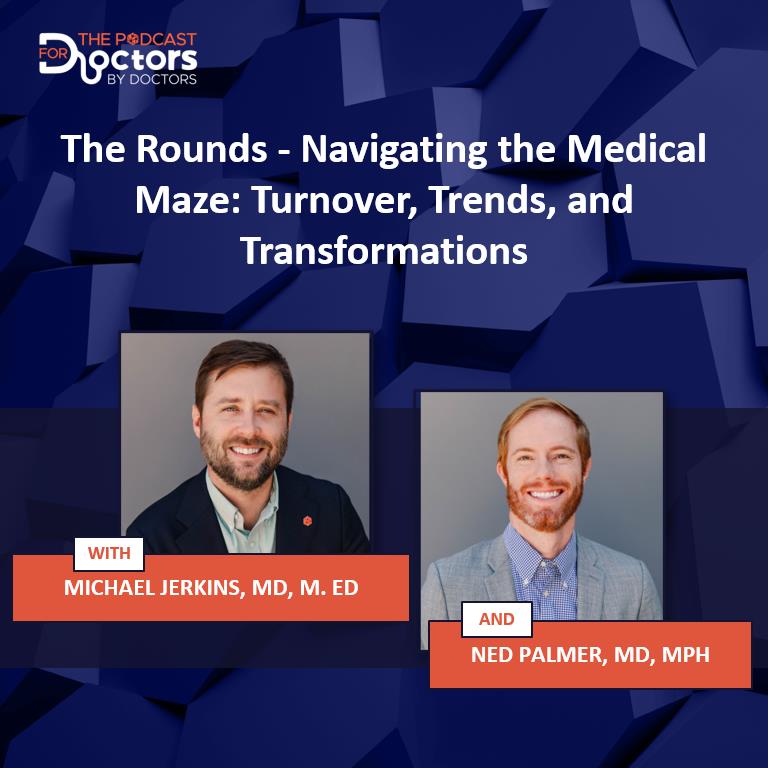Dr. Michael Jerkins and Dr. Ned Palmer tackle the pressing issues facing today’s physicians. From high turnover rates and burnout to the appeal of direct primary care models, they explore how doctors can regain autonomy, protect their well-being, and find balance in an increasingly complex and demanding healthcare landscape. They discuss the realities of hospital medicine, the pressures of episodic care, and the systemic factors driving many physicians to rethink their career paths.
What drives physicians to leave hospital medicine, and how can the next generation avoid the pitfalls of burnout? How can doctors navigate the nuances of job contracts and employment agreements while protecting their time and financial interests? And what lessons can be drawn from the evolving COVID-19 treatment pathways that highlight the need for flexibility and innovation in practice? Dr. Jerkins and Dr. Palmer break down these challenges with candid insights, real-world examples, and a mix of humor and practicality, offering actionable advice for physicians at every stage of their career.
Panacea Financial is not a law firm and provides no legal advice of any kind whatsoever. The information regarding legal matters shared on this website is provided for your private use and does not constitute legal advice or substitute for the advice of an attorney. If you require legal advice about a specific matter or question, you should consult with an attorney of your choosing or contact Panacea Legal Services panacea.legal.
Here are four takeaways from the conversation with Dr. Michael Jerkins and Dr. Ned Palmer:
1. High Turnover in First Jobs
The episode highlights the high turnover rates among physicians in their first jobs, often leaving within two to three years. Dr. Palmer attributes this to demanding schedules and burnout, emphasizing the need for better work-life balance and understanding of job contracts.
2. Direct Primary Care as a Growing Trend
Dr. Jerkins and Dr. Palmer discuss the shift towards direct primary care models, where physicians operate on a subscription basis. This model offers doctors more control over their schedules and patient interactions, appealing to those seeking autonomy in their practice.
3. Challenges in Hospital Medicine
The conversation reveals the episodic nature of hospitalist work, which lacks continuity of care and contributes to higher turnover rates. Dr. Palmer compares hospital medicine to emergency medicine, noting the pressures that lead many hospitalists to consider outpatient roles.
4. Importance of Contractual Awareness
The hosts emphasize the importance of understanding job contracts, sharing anecdotes of physicians misled by employers. Dr. Jerkins stresses the need for legal advice when negotiating job offers to avoid pitfalls and ensure job satisfaction.
Transcript
Ned Palmer:
Frankly, you feel like you’ve gone back to being a resident. Like, you’re gonna show up, and you’re not allowed to call in sick. There’s really no backup for a lot of what you’re doing. We don’t really have a call or jeopardy schedule anymore—it’s like, you just work. Who would find enjoyment in that kind of structure?
Michael Jerkins:
Welcome back to another episode of The Podcast for Doctors, by Doctors. I’m Dr. Michael Jerkins, and this is a very special day because it’s not just me—it’s both of us together. Do we want to reintroduce ourselves? This might be the first time in a year. Wait, what’s your name?
NP:
I think we ought to. I’m Dr. Ned Palmer, and I’m excited to be the co-host and interviewee of Doctors by Doctors today.
MJ:
Yeah, well, it’s kind of just a conversation. I guess in every conversation, someone plays the part of interviewer and interviewee a little bit—if it’s a good conversation at least. But yeah, it’s exciting to be with you today.
We have some topics we’re going to cover. We don’t have an amazing guest—just an amazing number of topics to talk about. It’s kind of a weird season. If you’re not in healthcare, it’s hard to know where we are in the calendar when it comes to how doctors think about jobs and next steps.
It’s the fall, which is interesting because you have medical students working on residency applications and thinking about the Match.
NP:
Probably already interviewing for some of them.
MJ:
Exactly. And depending on when this episode airs, you’ve got fourth-year dental students, vet students, residents, and fellows all thinking about their first jobs. Hopefully, they’ve interviewed or at least identified places they want to go.
Then you’ve got those already post-training—their contracts might be coming up in June or July, or even May—and now’s the time they’re starting to think: Do I want to renew? Get a new job? What am I even doing?
So fall feels like a good time to talk about the physician workforce. I want to bring that home a little, even for people not in healthcare.
Recently, I’ve had several conversations with folks frustrated about having a new primary care provider or specialist every few months. One person told me they’ve had three different primary care providers assigned to them in the same office in just twelve months. Have you had this experience or heard about it as a patient, doc?
NP:
As a physician, I know this mostly from the patient side. As we talk about all the time, you and I are lucky to serve as doctors—but we’re all patients too. As a patient, basically every time I call in for my annual physical, I see someone different.
I go to one of the largest health systems here in Michigan—won’t name it—but pretty much every year, it’s a new provider. I understand the limited continuity even within the same office. Three providers in a year is on the high end, but still, it’s tough. Especially when you layer in complexity—parts of your history you want someone to know—or just the frustration of re-explaining things every time.
MJ:
When you think about doctor turnover, there’s the patient side, which obviously stinks because you’re re-explaining everything. Maybe the previous provider’s documentation wasn’t great, so you’re asked questions you’ve already answered. And then there’s rapport—you’re talking about your most personal details with a new person each time.
But there’s also the system side. Recruiting and hiring a new doctor can cost hundreds of thousands of dollars, sometimes more depending on the specialty.
So, given that physicians’ first jobs often last just under three years, why do you think that is? Why do doctors only stay in their first jobs for two to three years?
NP:
That’s definitely common, and it varies by specialty—especially for procedural or call-heavy roles. But in my experience as junior faculty, I actually worked more than I did as a resident or fellow.
During training, you have federal work-hour restrictions. There’s some gray area, sure, but once you become junior faculty, those restrictions are gone. You’re putting in more hours, more call, more time away from family. It’s kind of the nature of medicine—junior folks get asked to do the most to expand coverage.
So for many new doctors, that first job means more burnout, more exhaustion, and more time away. A couple of years in, you look around and think, Nothing’s getting better. I need to make a change.
There’s also geography. Something like 70% of residents practice within 50 miles of their residency program. They take the first job nearby because it’s convenient and familiar—but later realize there might be better options elsewhere.
So it’s a combination: excessive workload, limited perspective during residency, and later realizing there are better opportunities out there.
MJ:
Do you think most of that turnover is from the schedule side? Or is burnout—which we hear about constantly but don’t always define—an equal or greater factor?
NP:
It’s tough to separate the two. A bad schedule can cause burnout, and even a great job can be ruined by an awful schedule. “Burnout” is vague, but schedule is concrete—so I’d lean toward schedule being the bigger driver.
A lot of people don’t realize what their schedule actually means until they’re living it. You’ll hear, “One weekend a month,” but what does that mean? Thursday to Monday? Friday night to Sunday night? Those details matter.
MJ:
What do you mean?
NP:
Well, for example, my fiancée works in healthcare, and her job counts Friday as part of the weekend. So if she’s “on for the weekend,” that could mean Thursday at 5 p.m. through Monday at 6 a.m.—that’s a long weekend.
So people agree to things without fully understanding the mechanics. That misunderstanding can be crippling.
MJ:
It sounds like what you’re saying is that it would be really helpful for physicians to talk to an attorney before—or even after—they sign their contract, to really understand their schedule. Because apparently, that’s one of the biggest determinants of job satisfaction. (And I’m not sure “determinant” is the right word there.)
NP:
You’re close—it’s “determinant.”
MJ:
This is why I need an attorney just to read my emails.
NP:
Yeah—like the social determinants of health.
MJ:
Exactly. “The Determiners” might actually be a good band name.
But seriously, this is why contract review makes so much sense for doctors. I heard about a fellow who’d just graduated and was asked if they had an attorney review their contract. They said no—the employer told them it was their “best offer,” so they didn’t think a review would help.
It’s funny but also sad. It shows how unprepared we are for this stuff. A big employer says, “This is our best offer,” and you think, Okay, must be true.
And it makes sense that doctors only stay two or three years in their first job. You sign a contract you don’t fully understand because you’ve never done it before. Eighteen months in, you realize, This isn’t what I expected. The second time around, you’re wiser, you know the questions to ask, and you understand why an attorney is worth it.
NP:
Exactly. From the employer’s side, once they’ve got you locked in, they’re unlikely to offer big raises to get you where you should be. That’s another reason doctors turn over early.
Even when people try to negotiate, employers often say no—they’re bound by 3–5% adjustments at most. So doctors have to move to make a meaningful change. It’s frustrating to realize what you agreed to won’t make you happy as a practitioner.
MJ:
And you haven’t even been an attending before, so it’s hard to understand what your day-to-day will really be like. Training is totally different—you’re in the thick of it with your colleagues.
NP:
Right. And think about the psychology of it—you’re a resident making $50,000 a year, working an exhausting schedule. Then one day, during rounds, you get a job offer for four or five times that amount. You’re thrilled. You think, Finally, I can breathe. I can pay my bills. I can eat.
Employers know that. They understand the psychology and use it. They know the moment that offer lands, you’ll want to sign immediately. And that can lead you to accept a contract that looks good at first—but may not actually work for you long term.
MJ:
So there was a McKinsey analysis on this, and most doctors—when they talked about retention, what makes you stay in a job—51% of physicians said that schedule flexibility was the key retention factor.
NP:
Is that one of the highest retention factors from that study?
MJ:
That is one of the highest, yes.
NP:
One of the highest. Yeah, I completely believe that. Right, because if you think of the corollary of schedule inflexibility, frankly, you feel like you’ve gone back to being a resident. You’re going to show up, and you’re not allowed to call in sick, and there’s really no backup for a lot of what you’re doing. We don’t really have a call schedule or a jeopardy schedule anymore—it’s like, you just work. Who would find enjoyment in that kind of structure of “thank you for telling me exactly when and where I need to be and giving me no flexibility”?
MJ:
I think about it from the primary care perspective, and we’ve all seen the studies showing that if a primary care doctor did all the recommended screenings and counseling for every patient in their schedule, it would take them something like 27 hours in a day. And if you’re in a system—everyone listening who’s in primary care understands this—the system then says, “Well, you guys are losing us money. The primary care office is losing the system money.”
NP:
In a day.
MJ:
And you should feel lucky that we even employ you. It’s like a favor we’re doing for you. And keep in mind, they’re not adding the revenue your clinic generates for the system—from the tests you order, the imaging, the referrals to specialists, all the surgeries and procedures downstream from your work. They actually have to have you, but they don’t show that. They don’t attribute that revenue to you—they just attribute your direct billings.
And so, there’s this aspect of “you’ve got to do more.” They say, “You’re losing money, so you’ve got to see more patients.” They do this fake…
NP:
Yeah, your fake divisional analysis.
MJ:
Exactly. A doctor I work with calls it “funny money.” He’s like, “That’s some funny money right there.” It is—you get a printout of your expenses and P&L and you’re like, “What is this number, and where did it come from?” And no one can actually answer it. But they use that to say, “You’ve got to do more, you’ve got to see more, you’ve got to complete all the stuff Epic flags before you close a chart.”
And what’s happening, especially in the primary care space, is that people are saying, “I don’t want to do this anymore.” Many of them are moving to or exploring a direct primary care or concierge medicine model.
For those who might not be familiar, direct primary care is a subscription-based model for primary care—though there are also subscription-based models for specialists. Essentially, the patient pays a monthly or annual fee, depending on the model, and then has direct access to their doctor. They can schedule when they want, they get more time, and for the doctor, that means schedule flexibility—they’re their own employer. They can see patients at their own pace.
So it’s interesting to see these market forces pushing doctors to say, “I’m not doing this anymore. I’m going to my own model.” But the other question that comes up is: what does that mean for patients who can’t afford an extra monthly fee for a subscription? They’re already struggling with insurance premiums or relying on government insurance.
I don’t know—I just rambled there, but I feel like we’re seeing a big shift toward direct primary care.
NP:
Yeah, and this is an area I approach delicately as a hospitalist, not a primary care insider. But all the forces are there. Even going back to your initial question—what have we all experienced as patients recently? If you’re a patient in a large health system, have you gotten more time with your doctor in the last five years? More personalization? A provider who knows you better? No. None of those are true.
We’ve seen visits go from 45 minutes to 30, to 25, to now 20—even for routine physicals. It’s necessarily scripted, making sure the high points are covered because those are the billing checkboxes in Epic or whatever software is masquerading as an EHR.
So of course, this class of primary care providers has felt the quality of care deteriorate. They want those relationships back. I always wonder—do you have any stats on adoption from the patient side?
I’ve seen that patient satisfaction has gone up, but in heavily subscribed areas, I’d love to know what data exists on direct primary care—on quality, patient happiness—all those outcomes that should, in theory, be improving.
MJ:
Let me first say that the recent “big, beautiful bill,” whatever you want to call it, allows people to use their HSA dollars to pay for direct primary care fees—which previously you couldn’t. So, in theory, demand for DPC should increase because it’s now more affordable.
You’re also seeing employers partner with DPCs and send their employees to them. Some data show that lowers employer costs, which would accelerate adoption. According to the Direct Primary Care Coalition, there are now about 2,300 DPC practices in 48 states, reportedly serving 300,000 American patients.
I’ve seen different numbers—it’s not consistent—but essentially, a little over 2,000 practices and between 200,000–300,000 patients in the U.S. receive their care through this model.
NP:
Those are amazing stats—bigger than I thought, which is awesome to hear. And those numbers are before the biggest funding change you just described.
I always think of the other end of the spectrum—the for-profit, private-equity-owned institutions. It seems like every month, there’s a new study showing a decline in quality, an increase in morbidity and mortality at those most corporatized healthcare systems.
So even being the opposite of that, maybe it’s still early to say DPC’s quality outcomes are superior—but intuitively, it feels like they will be. You get more time, more attention, and more individualized healthcare, instead of the cookbook medicine you’re forced into when everything’s dictated by an EHR and billing quotas.
MJ:
So let me ask this—we’ve talked about workforce and how it’s affected outpatient doctors moving into concierge or direct models. I think if you looked at inpatient doctors, my guess (and there’s some data here) is that hospitalists have the highest turnover relative to most inpatient specialties.
And then, how many hospitalists eventually transition out of inpatient care altogether to outpatient? Do you see much of that?
NP:
I do. I don’t have the exact numbers, but I see both—turnover and transitions. Turnover happens more often than a full move to outpatient, just because that’s easier—you’re taking the same role at a different institution.
Hospitalists don’t have follow-up. Even surgical subspecialties have some continuity; hospitalists don’t. It’s almost purely episodic, much closer to emergency medicine: “This is your episode of care, I’ll sign out, and that’s it.” It’s truly shift work, which makes people more portable.
I’d be curious to compare hospital medicine and emergency medicine turnover. But yes, I’ve seen colleagues move into outpatient or even direct primary care or concierge models. They’re seeing 20–22 patients per day, feeling like they can’t give proper attention, and just want control over their time and ability to practice medicine.
Hospital medicine, like primary care, “loses money.” Everyone says it’s a loss leader—but again, that’s funny money. They don’t factor in referrals, imaging, lab work, or specialist revenue from complex patients.
So the same pressures exist inpatient and outpatient. It’s not surprising that more hospitalists are leaving for direct care models to reclaim control.
MJ:
As for hospital medicine turnover, it’s about 11% annually—anywhere from 8–10%, compared to around 7% for all physicians. So it’s higher, which makes sense. You go into it early in your career, working holidays, nights, weekends—and eventually, you’re like, “I’m tired of this.” It goes back to the schedule.
NP:
Right, it goes back to the schedule. And as shift-work labor, it’s relatively easy to move around. Early-career attendings may be younger, have smaller families, and are more willing to relocate. You’re not winding down a patient panel—you can just show up, learn the EHR, and start working.
That makes it easy to shop for contracts and compensation. So if you got the first one wrong, you’re more likely to keep evaluating and move again, because it’s relatively easy to trade in and out.
MJ:
There’s an AMA survey that looked at doctors who were interested in leaving their job in the next two years, broken down by specialty. I have the top 10 with the lowest intent to leave and the top 10 with the highest intent. Do you have any guesses for the specialties with the highest intent to leave their job in the next two years?
NP:
Preventive care or public health? Maybe they’re all already gone. Family medicine? Are they specialists or generalists? Give me something here—I’ve not seen this one.
MJ:
Nope, try again.
Number one specialty with the highest intent to leave in the next two years is Anesthesia. Number two is Vascular Surgery. The rest are Radiology, General Surgery, ENT, Pulmonology, Cardiology, Psychiatry, GI, and Ophthalmology. The specialty with the lowest intent to leave?
NP:
Pediatrics. Dermatology—interesting.
MJ:
Dermatology. I mean, I had the answers in front of me, but…
NP:
Do they mean leave their job or leave their specialty?
MJ:
Just to leave their current position, yeah.
NP:
Leave their current position—okay, so derm gets in and stays. That’s interesting.
MJ:
Derm gets in and stays. Actually, you’re right—Peds is number three.
NP:
That one I felt better about—less likely to leave their jobs. They have patient panels, deep investment, longitudinal relationships. Almost all of those high-leaving specialties were procedural, except psychiatry.
Anesthesia at the top is always funny. Anesthesiologists are often seen as entrepreneurial, business-minded. Maybe they understand that by shopping around or jumping jobs, they have more opportunities.
MJ:
Maybe. I don’t know the data on who works the most locums, but I’d guess anesthesia is one of the highest.
But Ned, we have one last segment I’m very excited about. This segment is called “What Specialty Would They Be?” In this segment, I name a non-physician job, and you tell me what specialty you think they’d be if they were a doctor.
NP:
I like this. It’s my job, not the person, right?
MJ:
Yes, the job. First one: accountant. What specialty would an accountant be?
NP:
Infectious disease. Why? It’s the most forensic. Who else is going to go that deep—“Did you own a turtle when you were six? Can I get a tax break for it?” I could also see nephrology—very numbers-based, fact-finding. I was thinking of accountants from the deep dives they take.
MJ:
I thought nephrology.
NP:
Yes—nephrology is very numbers-based; everything’s a calculation of a calculation.
MJ:
Next: school teacher.
NP:
Pediatrics, because of the patients and families. Just like a teacher, you’re not just dealing with the child—you’re working with the entire family unit.
MJ:
I think you’re right. It also depends if you teach junior high or high school—adolescent medicine, maybe.
Next: professional athlete. Does it depend on the type of athlete? Long-distance runner—you think they’d be ortho?
NP:
Yeah, I’m thinking of professional athletes who make a living from sports, like MLB, NFL, NHL, MLS—they’re ortho. I can’t imagine anything else.
MJ:
Actually, funny story—I’ve interviewed a lot of long-distance runners and ultra-marathoners, and they all seem to be pediatricians.
NP:
That’s an odd overlap. But yes, professional athletes in my mind are ortho.
MJ:
Next: sales.
NP:
I’d think of the guy in the OR selling Striker equipment—that doesn’t count. Totally blank—why urology?
MJ:
I think urologists are the most entrepreneurial of all specialties—adult urologists specifically. Pediatric urologists, not so much.
NP:
Interesting. I was going to say transplant medicine—they’re always convincing people. But I get your entrepreneurial reasoning.
MJ:
Next: police officer.
NP:
General surgery. Ever been in an OR with a general surgeon? They’re the law in those four walls—everything has to be exact, or you go to med student jail.
MJ:
Accurate. Surgical subspecialty could work too. Next: attorney.
NP:
Technology. Two cardiologists, same EKG, three different opinions—that’s like lawyers. Ask two lawyers the same question, get three to five answers.
MJ:
I’d say internal medicine—overlap with cardiology.
NP:
Heavy overlap—they argue, disagree, question everything.
MJ:
Yes, lots of questions. Not always valuable, but we like to talk. I’m an internist, and my grandmother said I should have been an attorney—maybe I argued a lot.
Last one: musician.
NP:
Nephrology. Some of the best musicians I’ve known were nephrologists. Analytical, structured thinking applied to medicine—pianists specifically.
MJ:
Interesting. You’d expect plastic surgeons or vascular surgeons for dexterity, but nephrologists, okay. Maybe someone in the comments will explain why.
NP:
I’ve known ENTs and procedural specialists who were excellent, but my own social network showed a consolidation around nephrology.
MJ:
There you have it. If you become a nephrologist, you’re more likely to be a pianist—at least in the style Dr. Palmer likes.
Ned, we always end with the same question: what’s one thing you’ve changed your mind about recently?
NP:
Classical pianist, of course. One thing I’ve changed my mind about is new and novel treatments for COVID. We’ve seen an uptick in cases over the last three months from a hospitalist standpoint.
I’m monitoring and evaluating treatments we used previously—like dexamethasone and Paxlovid—and how they fit into current treatment pathways. What’s changed my mind is that some previously established pathways aren’t seeming as effective, so there’s more fluidity than I expected. My confidence in previously established inpatient COVID treatment pathways has changed.
MJ:
That’s a very substantive answer. I appreciate you being here, Dr. Palmer, and the discussion on doctors as employees and patients. I’d love to hear feedback on “What Specialty Would They Be?” Tell us where we’re wrong. Thanks for joining another episode of the Doctors by Doctors podcast.
NP:
Thank you, Dr. Jerkins.
MJ:
You can catch The Podcast for Doctors (By Doctors) on Apple, Spotify, YouTube, and all major platforms. If you enjoyed this episode, please rate and subscribe. Next time you see a doctor, maybe prescribe this podcast. See you next time.
Check it out on Spotify, Apple, Amazon Music, and iHeart.
Have guest or topic suggestions?
Send us an email at [email protected].

Feeling Disappointed On Match Day? What’s Next? – Match Day 2026
According to the NRMP 2024 Main Residency Match Results and Data, less than half of all Match Day applicants were matched with their first choice...

What To Do If I Didn’t Match: SOAP Tips & More
Every year, thousands of medical students apply and interview for residency. In 2025 alone, 47,208 applicants submitted a certified rank order list of their preferred...

What Happens If I Didn’t Match Into A Residency Program?
If after completing SOAP you are still unmatched, it is important to take a moment to rest. Though you will not be entering residency this...



